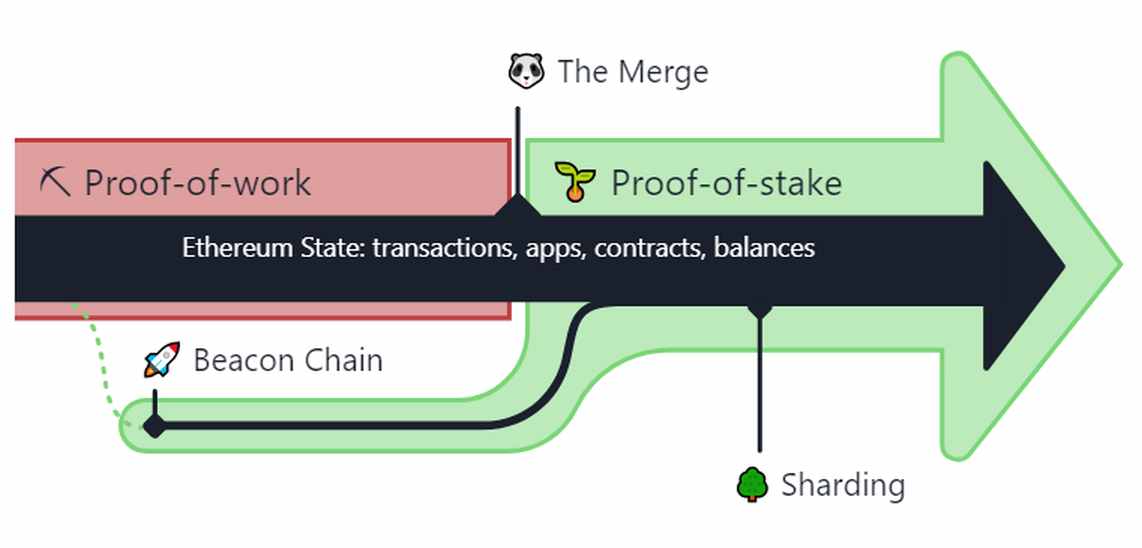The Ethereum ‘Merge’ is finally here, ushering in a new era for energy-saving blockchain based on proof-of-stake

The highly anticipated Ethereum ‘Merge’ is finally here. On Thursday, Ethereum, the blockchain that underpins the world’s second-largest crypto token ether, successfully underwent a major software upgrade that drastically reduces the amount of energy needed to create new coins and carry out transactions, Ethereum inventor and co-founder Vitalik Buterin tweeted on Thursday.
The Merge was finally completed today after a six-year buildup. As of 2:43 EST this morning, Ethereum now uses proof of stake, a way to approve new transactions that promises to cut the blockchain’s energy usage by as much as 99.9% and usher in a new era for the second-largest cryptocurrency.
According to Ethereum Foundation, the new system will use 99.95% less energy. The upgrade, which changes how transactions occur and how ether tokens are created, could also give Ethereum a major edge as it seeks to surpass rival blockchain bitcoin.
Ethereum co-founder Vitalik Buterin said the long-awaited shift to ‘proof-of-stake’ could reduce carbon footprint and solve environmental woes that have plagued cryptocurrencies over the years. In a Twitter post at 2:59 AM EST, Vitalik said:
“And we finalized! Happy merge all. This is a big moment for the Ethereum ecosystem. Everyone who helped make the merge happen should feel very proud today.”
And we finalized!
Happy merge all. This is a big moment for the Ethereum ecosystem. Everyone who helped make the merge happen should feel very proud today.
— vitalik.eth (@VitalikButerin) September 15, 2022
So What is The Merge?
- Ethereum Mainnet uses proof-of-stake, but this wasn’t always the case.
- The upgrade from the original proof-of-work mechanism to proof-of-stake was called The Merge.
- The Merge refers to the original Ethereum Mainnet merging with a separate proof-of-stake blockchain called the Beacon Chain, now existing as one chain.
- The Merge reduced Ethereum’s energy consumption by ~99.95%.
“The Merge” is a game-changer and a major upgrade to the Ethereum cryptocurrency ecosystem. To fully appreciate the value of this upgrade, we first need to understand how blockchain and cryptocurrencies work.
First, Bitcoin, Ethereum, and other major cryptocurrencies use a consensus algorithm known as Proof-of-Work (PoW) to secure their blockchain networks. The PoW requires a miner to solve a complicated algorithm to verify transactions within a block. This allows information to be stored in a distributed, decentralized manner across many nodes in a network (e.g. The Internet) while remaining secure, reliable, and dispute-free. (There are alternatives to PoW which are far more efficient, but PoW is currently the most widely used).
Unlike the PoW which requires miners to solve a complicated algorithm to verify transactions within a block, Proof-of-stake (POS) was created as an alternative to the original consensus mechanism used to validate a blockchain and add new blocks. While PoW mechanisms require miners to solve cryptographic puzzles, The POS model allows cryptocurrency owners to stake coins and create their own validator nodes. Staking is when you pledge your coins to be used for verifying transactions. Your coins are locked up while you stake them, but you can unstake them if you want to trade them.
Here’s how Ethereum Foundation explained The Merge on its website:
“The Merge was the joining of the original execution layer of Ethereum (the Mainnet that has existed since genesis) with its new proof-of-stake consensus layer, the Beacon Chain. It eliminated the need for energy-intensive mining and instead enabled the the network to be secured using staked ETH. It was a truly exciting step in realizing the Ethereum vision—more scalability, security, and sustainability.”

What happened to ‘Eth2’?
According to the Ethereum Foundation website, the term ‘Eth2’ is being phased out in preparation for The Merge. After merging ‘Eth1’ and ‘Eth2’ into a single chain, there will no longer be two distinct Ethereum networks; there will only be Ethereum.
To limit confusion, the Ethereum community has also updated these terms:
‘Eth1’ is now the ‘execution layer’, which handles transactions and execution.
‘Eth2’ is now the ‘consensus layer’, which handles proof-of-stake consensus.
Post-Merge and Ethereum Market Share
So what does this mean for the future of Ethereum? Ahead of the Merge, Ether took market share from bitcoin and now accounts for about a fifth of the $1 trillion crypto market while Bitcoin’s share has dropped to 39.1% from this year’s peak of 47.5% in mid-June, according to a report from Reuters.
In addition to energy consumption, high costs and slow transaction times are key issues facing the Ethereum network. Merge will not immediately tackle these problems, though some analysts say it lays the ground for Ethereum’s expansion.
The bolstering of Ethereum’s environmental, social and corporate governance (ESG) credentials “would be good for regulatory-driven institutions that want to start to explore the Ethereum ecosystem,” Marc Arjoon, Ethereum research analyst at digital asset manager CoinShares told Reuters.




